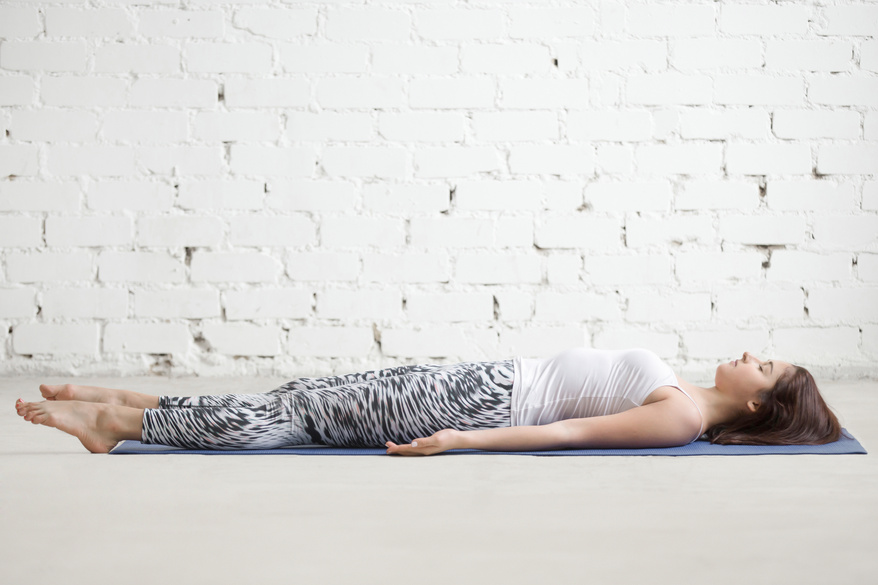Shavasana
With appropriate practice of asanas, you can learn to relax while performing an activity or while physically resting. Relaxation with awareness and knowledge brings deep rest to both body and mind. You can apply this skill of resting even during effort and in daily life. Relaxing asanas can be practiced at any time of day when the body feels tired. These relaxing asanas include:
Corpse Pose (Shavasana)
In this final rest, you absorb the benefits of your asana practice. You experience a deep sense of peace and calm while assimilating all the positive energy you've created around yourself. Allocate 5 minutes of final rest for every 30 minutes of asana practice, with a total rest time of up to 15 minutes.
The more you relax physically and mentally, the deeper and calmer your rest will be.
(You can use a sweater, socks, or blanket to keep warm during the final rest.)
Lie on your back;
Inhale and tense your entire body from head to toe: hold the breath, clench your fists, tighten all facial muscles and every muscle in your body;
Exhale through the mouth with a “haaa” sound and release all tension;
Repeat once more;
Now lie in a comfortable position. Keep your eyes closed;
Relax every part of your body;
Mentally relax the body by moving your awareness through each part, starting from your feet and ending at your head; feel grateful for each part of your body. Gratitude enhances physical and mental relaxation;
Allow Mother Earth to take your entire weight, feeling the body become very light. A relaxed body feels light;
Let the breath relax by becoming aware of it, allowing it to become smooth, quiet, and calm;
Now let your mind relax, releasing all worries, fears, anxiety, or agitation. Surrender them to God. Let go of future plans and past events—remain in the present moment;
Rest in the peaceful and blissful space within you;
After a few minutes of rest, bring your awareness back to your body and take a few deep breaths;
Gently roll onto your right side;
Slowly return to a seated position;
Chant OM 3 times;
Gently open your eyes in your own time.
When to Practice Shavasana (Corpse Pose)?
After dynamic exercises such as Surya Namaskar;
Right before sleep (provides the greatest benefit);
After a long or demanding workday.
Duration:
Minimum 3–5 minutes. The longer, the better.
Benefits:
Relaxes the psycho-physiological system.
Develops body awareness.
Reverse Corpse Pose (Advasana)
Lie on your stomach;
Stretch your arms overhead with palms facing down;
Breathe naturally and rhythmically, relaxing your body in the same way as in Shavasana;
You may place a pillow under your chest if breathing feels difficult.
Duration:
A few minutes per asana session is sufficient. Can be practiced for as long as needed for healing purposes.
Benefits:
Recommended for people with:
Herniated disc
Stiff neck
Rounded posture
Superior Pose (Jestikasana)
Lie on your stomach with your forehead on the floor;
Interlace your fingers and place your palms on the back of your head;
Keep your elbows on the floor;
Relax the body just like in Shavasana.
Benefits:
Jestikasana is beneficial for those suffering from:
Cervical spondylitis
Neck and upper back stiffness
Crocodile Pose (Makarasana)
Lie still on your stomach;
Make a pillow with your elbows and rest your head on them—elbows should touch the ground;
Keep your elbows together for a more pronounced spinal arch;
Slightly separate the elbows to reduce pressure on the neck;
The two focus points of Makarasana are the neck and the lower back. Adjust the elbows precisely to balance both;
Close your eyes and relax the entire body;
A variation is to rest your right cheek on your hands or rest your forehead directly on them.
Duration:
Minimum 3–5 minutes. The longer, the better.
Benefits:
Recommended for those with:
Herniated disc, sciatica
Lower back pain or other spinal disorders (Do not practice if in pain)
Asthma or other lung issues (allows more air to fill the lungs)
Flapping Fish Pose (Matsya Kridasana)
Lie on your stomach with fingers interlocked and resting on your head;
Bend your left leg and bring the left knee close to the ribs;
Keep the right leg extended;
Turn your arms to the left and rest your left elbow on your left knee;
Rest the right side of your head in the crook of your right arm;
Relax in this position, then switch sides.
Duration:
At least 3–5 minutes. The longer, the better. Can be used for rest and sleep.
Benefits:
Helps with:
Stimulating digestive peristalsis
Muscle contraction
Bowel relief
Preventing constipation






